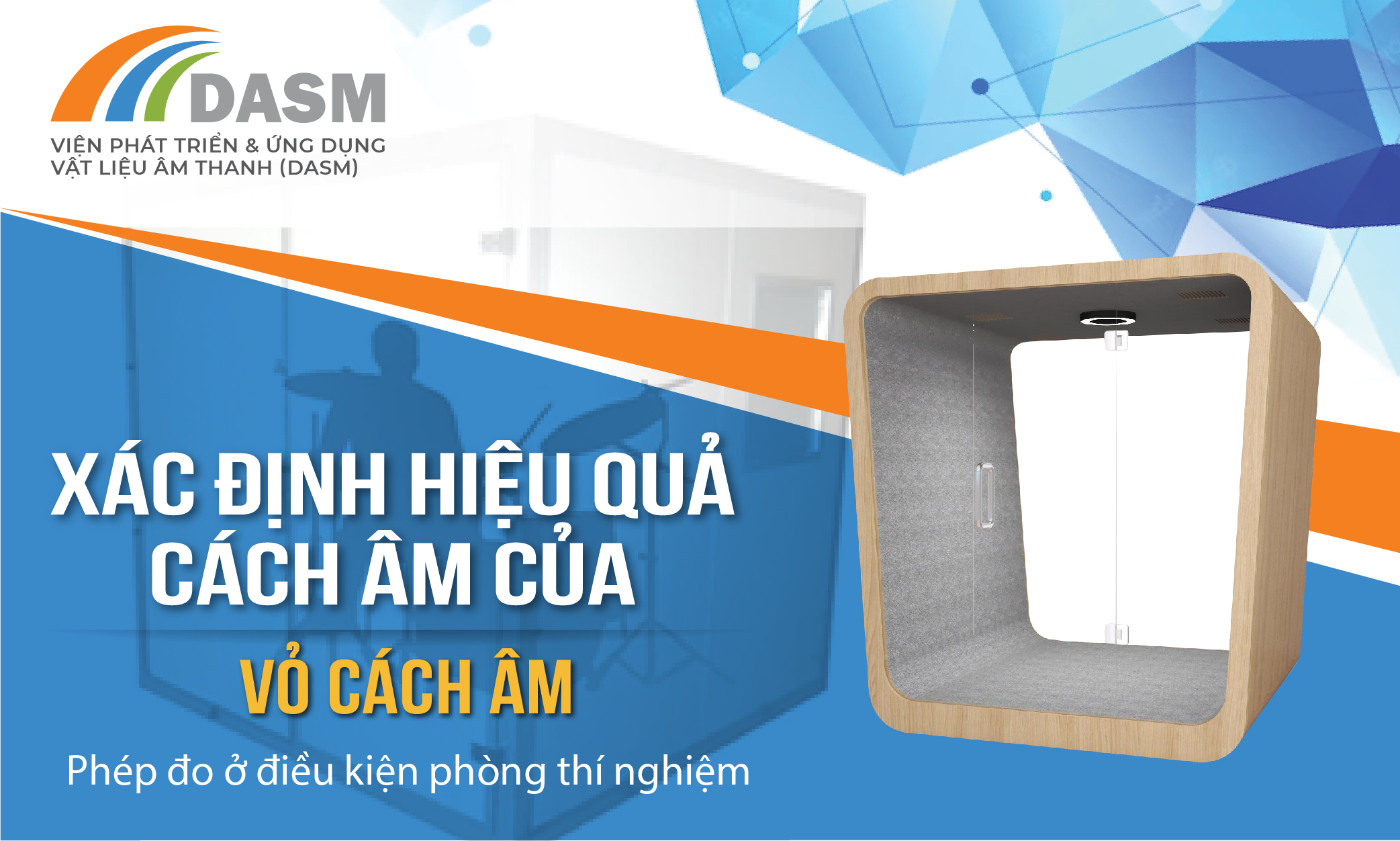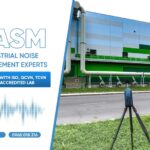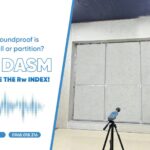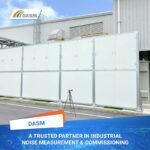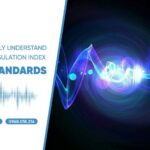Test for Determination of sound insulation performances of enclosures – Measurements under laboratory conditions helps determine the soundproofing effectiveness of soundproofing enclosures; meet the needs of customers who need to announce the results of materials – products which are eligible for installation, use, construction … in works and projects in a convenient and transparent way.
Overview of the test for Determination of sound insulation performances of enclosures – Measurements under laboratory conditions
Test name: Acoustics – Determination of sound insulation performances of enclosures Part 1: Measurements under laboratory conditions (for declaration purposes).
Test method:
ISO 11546-1:1995: Acoustics – Determination of sound insulation performances of enclosures – Part 1: Measurements under laboratory conditions (for declaration purposes) [1]
Conducted at: Laboratory, the Institute of Development & Application for Sound Materials.
1. Test target and subjects
Test target
This standard specifies a measurement method in-situ to determine sound insulation performances (sound attenuation) of soundproofing enclosures.
This standard does not apply to each part that makes up the soundproofing enclosure, but only to the entire enclosure.
Sound insulation performances of components that make up the enclosure such as walls, doors, windows, silencers, etc. must be measured in accordance with other relevant standards.
Standards relating to the test for Determination of sound insulation performances of enclosures – Measurements under laboratory conditions (TCVN 7839-1 (ISO 11546-1) and in cabins (ISO 11957).
The measurement methods specified in this standard are based on ISO 3740, ISO 9614, and ISO 11200 (see Table 1).
Depending on the method chosen, the sound insulation performances (Sound Attenuation) of the soundproof enclosure is determined by the attenuation of the sound power level or sound pressure level.
This method is proposed for measurement at the location where the soundproof enclosure surrounds the actual sound source (machine). If these methods are not possible, alternative methods such as using artificial sound sources can be used. These methods are also described in this standard.
– Test subjects
Entire enclosures.
– Select measurement method
The soundproofing performance value of a enclosure can only be accurately measured by measurements using a soundproofing enclosure designed for the actual sound source. Therefore, if possible, measurements should be made using a real sound source. If the soundproofing enclosure is fixed or attached to another sound source, the sound insulation performance can only be determined by the actual sound source. If it is not possible to use a real sound source, a permutation method using an external sound field can be used to determine the sound insulation performance. In cases where it is not possible to use both the real sound source method and the permutation method, the sound insulation performance can be measured using an artificial sound source inside the enclosure described in Appendix A. ( For enclosures that can be commonly used with sound absorbing materials on the inside and a small gap ratio (preferably <2%), this method is especially useful. Permutation method and artificial sound source method can be applied to enclosures with a volume of less than 2m3.
The more the enclosure has a gap ratio that deviates from the gap ratio and sound absorption standards, the more measurements must be made using the actual sound source. The permutation method and the artificial sound source method cannot be applied to tight-fitting soundproofing enclosure (wrapped and painted) because there is no free volume between the soundproofing enclosure and the surface of the real sound source. -In cases where a single value is required based on carrying out measurements using the permutation method or the method using artificial sound sources, the sound insulation calculated by weighted sound pressure, Dpr.w, is used. and soundproofing calculated as weighted sound power, DW.w, (See definitions 3.13 and 3.14). Weighted soundproofing is a single value that can be used to roughly compare different types of enclosures. However, this quantity should not be used as a general measurement of the soundproofing performance of enclosures because the actual soundproofing effectiveness depends greatly on the spectrum of the actual noise. If the actual noise level is known or assumed, the reduction in noise level according to characteristic A due to the use of enclosures can be estimated according to the method given in Annex C. NOTE 7. Measured data when using real sound sources is not necessary to compare with measured data when using the permutation method or artificial sound source method. In cases where the actual sound source is attached to a soundproofing enclosure, structural sound transmission can affect the measurement results.
– The test method applying to soundproofing enclosures without a real sound source
+ Permutation method
+ Artificial sound source method
2. Experimental procedure
Steps:
- Prepare and arrange equipment, microphone…
- Perform testing.
- Process and report results.
3. Note on Measurement Uncertainty
When using measurement methods using real or artificial sound sources that comply with this standard, a equal standard deviation or lower standard deviation than standard deviation of the international standard used will occur.
For the permutation method, the standard deviation in the frequency range from 250Hz to 10,000Hz approximates the standard deviation specified in ISO 3741. In the frequency range from 50Hz to 250Hz, the measurement uncertainty of additional measurement must be close to the desired standard deviation.
If a measured value is declared, it must be certified in accordance with ISO 4871.
The role and importance of the Test for Determination of sound insulation performances of enclosures – Measurements under laboratory conditions
The test for Determination of sound insulation performances of enclosures – Measurements under laboratory conditions conducted by the Institute of Development & Application for Sound Materials helps meet all practical needs of customers and businesses:
- Determine soundproofing performances (sound attenuation) of the soundproofing enclosure.
- Control quality during the production process, optimize research and development of soundproofing enclosures.
- Announce testing results to increase competitiveness – sales, or put materials – products into installation, use, construction… in works and projects in a convenient and transparent way.
In addition, if the test sample does not meet the standards, DASM will consult and design solutions for shape/structure/materials used to calibrate the design leanly, efficiently, and sparingly.
In the past, if you still had some concerns and wonders about spending a lot of money for similar acoustics services abroad, now you just need to contact with DASM. We will proactively carry out the entire remaining process in the fastest possible time to perfect the customer experience with us: DASM provides acoustics consulting services with truly outstanding quality and the most competitive fees in the industry along with excellent customer service policies.
Meaning of acoustic testing service at DASM
Today, globalized commercial life creates countless new markets and sources of supply across the world. To walk along them would be international regulations and standards to help customers easily assess the quality – trace the product’s origin, choose suitable / superior products. In particular, they also support manufacturers to constantly improve and better technology, techniques, materials, production methods, sales, etc.
The Institute of Development & Application for Sound Materials (DASM) is a pioneering, comprehensive, professional and prestigious brand in Vietnam in the field of acoustics. On January 12, 2023, DASM was granted a certificate No. 114/TĐC – HCHQ by the Directorate for Standards, Metrology and Quality (Ministry of Science and Technology) on certification of testing activities registration for multidisciplinary synthesis in the field of Mechanics (registration number: 707/TN – TDC).
Our acoustic testing services help customers get accuarate practical results which meet sustainability, standard performance. We also offer solutions – consulting – adjusting designs … to optimise products and services. As a result, you will update, meet and adapt to ever-changing international standards to break through in revenue, profit and elevate your brand.
At the same time, the test also optimizes your production processes – bring your products to market more quickly and economically; contributes to improving value, expanding markets, and spreading the advantages of products and services of businesses in Vietnam, in the region as well as in the international arena.
If you want to perform the Test for Determination of sound insulation performances of enclosures – Measurements under laboratory conditions, please contact Hotline for detailed advice!

